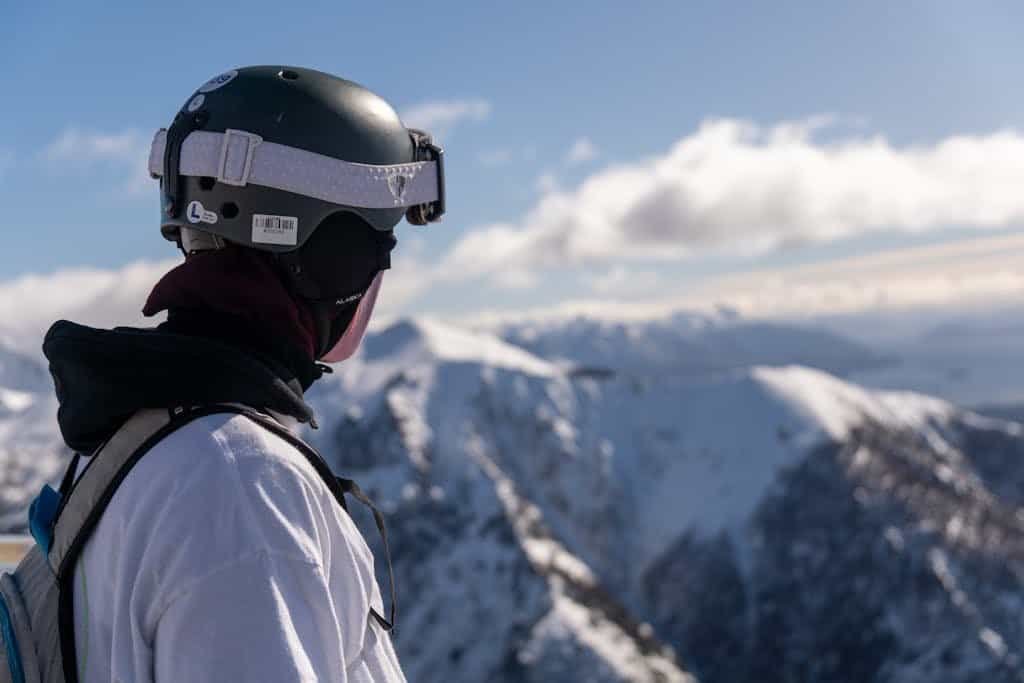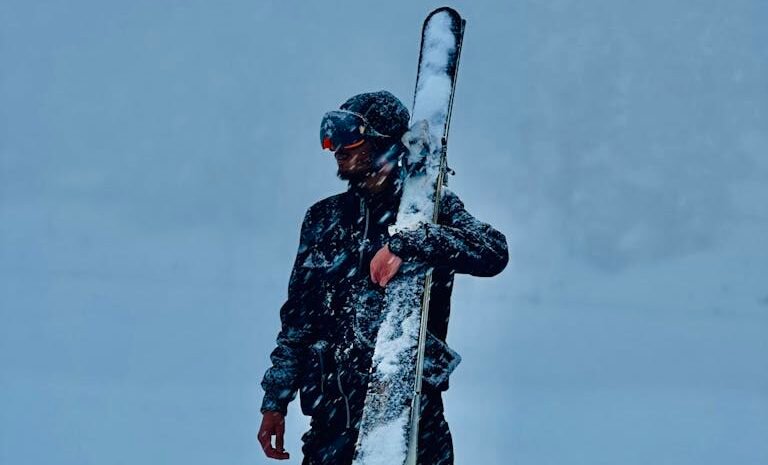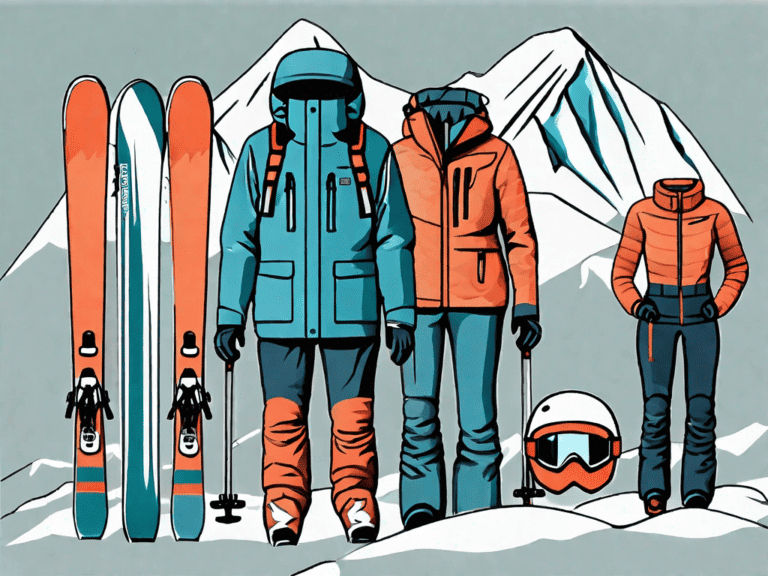How To Layer For Backcountry Skiing: Maximizing Comfort and Safety

Are you ready to conquer the backcountry slopes, but find yourself battling against the cold and damp rather than enjoying the thrill of the ski? As an outdoor enthusiast, I’ve navigated these challenges and discovered the key lies in learning the art of layering. Imagine effortlessly gliding through pristine snow, comfortably warm and perfectly ventilated, with each layer of your clothing harmoniously regulating your body temperature and managing moisture.
I invite you to join me in exploring the essentials of effective layering. This skill will elevate your backcountry adventures, keeping you focused on the joy of skiing, not the discomfort of the elements.
In this guide, I’ll share insights about layering for backcountry skiing, offering advice that ranges from choosing the right insulating materials to packing the essential skiwear for your adventure, ensuring you’re well-prepared for whatever the mountains may offer.
Key Takeaways
How to Layer for Backcountry Skiing?

It’s very important to learn how to layer properly for backcountry skiing. Years of personal experience in venturing into the Arctic wilderness, have helped me come up with a distinctive, step-by-step method that strikes a good balance between warmth, airflow, and flexibility. This method makes sure you’re ready for how the outdoors can change quickly.
- Skin Comfort Base: Start with a moisture-wicking base layer, such as merino wool or synthetic fabric.
- Insulation Engineer: Add a mid-layer for insulation, choosing between fleece, down, or synthetic based on the weather.
- Elemental Shield: Top off with a waterproof and windproof outer layer, like a hardshell or an insulated jacket.
- Accessory Accents: Don’t forget essential accessories – a warm hat, gloves, balaclava, helmets, and ski socks.
- Adjustment on the Go: Keep a lightweight, packable puffy jacket handy for quick warmth during breaks.
1. Skin Comfort Base: The Foundation of Warmth
The base layer is important in backcountry skiing, acting as a second skin. It’s the first defense against the cold and plays a vital role in moisture management and temperature regulation.
Merino Wool: This natural fiber is renowned for its ability to regulate body temperature. It keeps you warm in cold conditions and breathes well when it gets warmer. Merino wool is also naturally odor-resistant, making it ideal for multi-day trips.
Synthetic Fabrics: These are typically made from materials like polyester. They excel in wicking moisture away from the skin, drying quickly, and are often more durable than wool. They’re a great choice for high-intensity skiing where sweat is inevitable.
Both options have their unique advantages. Merino wool offers natural temperature regulation and comfort, while synthetic fabrics provide excellent moisture management and durability. Choosing a baselayer often comes down to personal preference, the intensity of the activity, and the specific conditions you expect to encounter in the backcountry.
2. Insulation Engineer: Mid Layer

The mid-layer in backcountry skiing is all about insulation and balancing warmth with breathability. It’s this layer that adapts to the body’s changing heat output during various activities.
Fleece: Known for its breathability and lightweight, fleece is a popular choice. It’s ideal for active skiing days, providing warmth without causing overheating.
Down: Offers excellent warmth-to-weight ratio, making it perfect for colder, drier conditions. However, its insulating ability decreases when wet.
Synthetic Insulation: Retains warmth even when damp, making it a reliable choice in wet conditions. It’s slightly bulkier than down but a versatile option for varied weather.
The goal is to maintain core warmth while allowing excess heat and moisture to escape, preventing overheating and sweat accumulation.
3. Elemental Shield: Outer Layer

The outer layer serves as the primary barrier against weather elements. This layer must be waterproof, windproof, and breathable, adapting to various weather conditions.
Hardshells: Ideal for extreme conditions, hardshell jackets offer maximum protection. They’re designed to be lightweight and highly protective against precipitation and wind. Most hardshells are equipped with features like sealed seams, adjustable hoods, and ventilation zips for temperature regulation.
Softshells: For days with less severe weather or high exertion activities, softshells are preferable. They provide good wind protection and are more breathable than hardshells, offering greater comfort during active skiing. Softshells are less waterproof, so they’re not recommended for heavy snow or rain.
Insulated Ski Jackets: Specifically designed for colder conditions, these jackets combine insulation (like down or synthetic fill) with external protection. They offer convenience by combining two layers into one but can be less versatile in terms of temperature regulation compared to layering separately.
Backcountry-Specific Features: Jackets designed for backcountry skiing often include features like powder skirts to prevent snow from getting inside, higher collars for better face protection, and pockets strategically placed for easy access even with a backpack on. Durability is also key, as backcountry skiing can be tougher on gear due to encounters with rocks, trees, and gear like crampons and skis.
Read my article about the best ski jackets for this season. I have also written a different article for the best women’s ski jackets to cater to our specific needs.
4. Accessory Accents: Specialized Gear for Backcountry Skiing

Ski Pants and Bibs: Essential for lower body protection, non-insulated, weather-resistant ski pants and ski bibs shield against the elements while allowing for breathability. Bibs offer additional coverage, keeping snow out and warmth in, especially during deep powder runs or falls. They are also practical, with added pockets and sometimes attachment points for gear.
Ski Socks: Quality socks, preferably made of merino wool, are vital for warmth, comfort, and moisture management. They prevent blisters, provide cushioning, and maintain warmth even when damp, which is crucial in cold and strenuous skiing conditions.
Gloves and Mittens: Layered gloves adapt to varying conditions. A liner glove provides basic warmth and can be used for tasks needing dexterity. Over these, waterproof and insulated gloves or mittens are essential for colder, wetter conditions. This layered approach allows for flexibility and ensures hands stay warm and dry.
Beanies and Ski Helmets: A good beanie keeps your head warm under a helmet and can be used during less intense activities. Helmets are critical for safety, protecting against impacts and potential head injuries. They should be lightweight, well-ventilated, and compatible with ski goggles.
5. Adjustment on the Go: Down or Synthetic Jacket for Emergency Warmth

In the unpredictable environment of backcountry skiing, carrying an emergency puffy – a packable down or synthetic jacket – is essential for emergency warmth. This jacket serves as an extra layer that can be quickly deployed during breaks, sudden weather changes, or emergencies. Down jackets offer an excellent warmth-to-weight ratio and can be compressed into a small size, making them easy to carry. Synthetic options, while slightly bulkier, provide reliable warmth even when wet. Having this jacket in your pack provides a safety net against the cold, ensuring you’re prepared for any situation in the backcountry.
Additional Layering Considerations
Avoiding Cotton Clothing: Cotton should be avoided in cold environments as it absorbs moisture and loses its insulating properties when wet. This can lead to rapid heat loss and an increased risk of hypothermia.
The Role of Sun Protection: Sun hoodies are important in backcountry skiing for their UV protection. The high altitude and reflective snow increase sun exposure, making skin and eye protection crucial.
Ventilation and Micro-adjustments: Garments with full zippers and side zips offer crucial ventilation options, allowing for quick temperature control during varying levels of activity.
Preparation for Extreme Elements: Windproof layers and waterproof gloves are essential for protection against harsh weather conditions. They help maintain warmth and dryness, ensuring safety and comfort in extreme environments.
Advanced Layering Techniques
Seam Taping and DWR Treatment
Seam taping and DWR (Durable Water Repellent) treatment are critical for maintaining comfort and protection. Seam taping involves covering the stitch lines of a garment with waterproof tape, ensuring no water seeps through these vulnerable areas. This is especially important in heavy snow or rain conditions.
DWR treatment, applied to the fabric’s exterior, causes water to bead up and roll off instead of soaking in. This not only enhances the garment’s waterproofing but also maintains its breathability, as wet fabric tends to inhibit the passage of air and moisture. Over time, DWR coatings can wear off but can be reapplied to extend the garment’s life. This combination of seam taping and DWR treatment provides a robust defense against the elements, keeping skiers dry and comfortable in various backcountry conditions.
2-Layer vs. 3-Layer Construction
Shell garments come in different constructions. A 2-layer construction typically involves an outer fabric bonded to a waterproof membrane, suitable for moderate activity. 3-layer construction, where the membrane is sandwiched between an outer fabric and an inner liner, offers increased durability and functionality, ideal for more intense backcountry conditions. Understanding these differences helps in selecting gear that matches your skiing intensity and the environmental demands.
Key Considerations For Layering for Backcountry Skiing
- Moisture Management: Choose base layers that wick moisture away from the skin to keep you dry.
- Adaptability: Use layers that can be easily added or removed to regulate body temperature during varying activities.
- Weather Protection: Ensure outer layers are waterproof and windproof for protection against the elements.
- Breathability: Opt for breathable fabrics to prevent overheating, especially in mid and outer layers.
- Material Selection: Consider the pros and cons of different materials like merino wool, fleece, down, and synthetics.
- Fit and Comfort: Ensure layers fit well without restricting movement.
- Specialized Gear: Include ski-specific accessories like socks, gloves, and hats for complete protection.
- Emergency Layer: Carry a packable insulated jacket for unexpected drops in temperature or breaks in activity.
How to improve your backcountry skiing experience?
To enhance your backcountry skiing experience beyond the scope of this layering tutorial, consider the following steps:
- Skill Development: Improving your skiing technique and physical conditioning can significantly enhance your backcountry experience. Consider taking advanced skiing courses or engaging in regular fitness training tailored to skiing.
- Gear Knowledge: Deepening your understanding of ski gear, from the latest ski technology to advanced safety equipment, can further improve your backcountry outings. Staying updated with new gear releases and reviews helps in making informed choices.
- Avalanche Education: Knowledge of snow science and avalanche safety is crucial in the backcountry. Participating in avalanche safety courses and regularly practicing with your beacon, shovel, and probe can be life-saving.
Alternative Approach to Layering
While the layering approach detailed in this tutorial is highly effective, there are alternative methods worth considering:
- Integrated Ski Suits: For those seeking simplicity and ease, integrated ski suits, which combine multiple layers in one, can be a good alternative. These suits offer convenience and often have advanced features for temperature and moisture management.
- Active Insulation Technology: Garments using active insulation balance warmth and breathability dynamically, adapting to your body’s heat output. This technology can reduce the need for frequent layer adjustments. Learn more about this technology from Polartec.
- Natural Fiber Blends: Exploring natural fiber blends beyond merino wool, such as bamboo or alpaca, can offer unique benefits in comfort and temperature regulation, providing viable alternatives for base and mid-layers.
Conclusion
Effective layering for backcountry skiing involves a strategic combination of moisture-wicking base layers, insulating mid-layers, and protective outer layers. This approach ensures temperature regulation, comfort, and protection against the elements. Drawing from personal experience and interviews with experienced people from the Arctic, my recommendations in backcountry skiing are designed to optimize your performance and safety. Embracing this layering method will enhance your skiing experience, allowing you to tackle the backcountry with confidence and enjoyment. Remember, the right layering strategy can make all the difference in your backcountry adventures.






